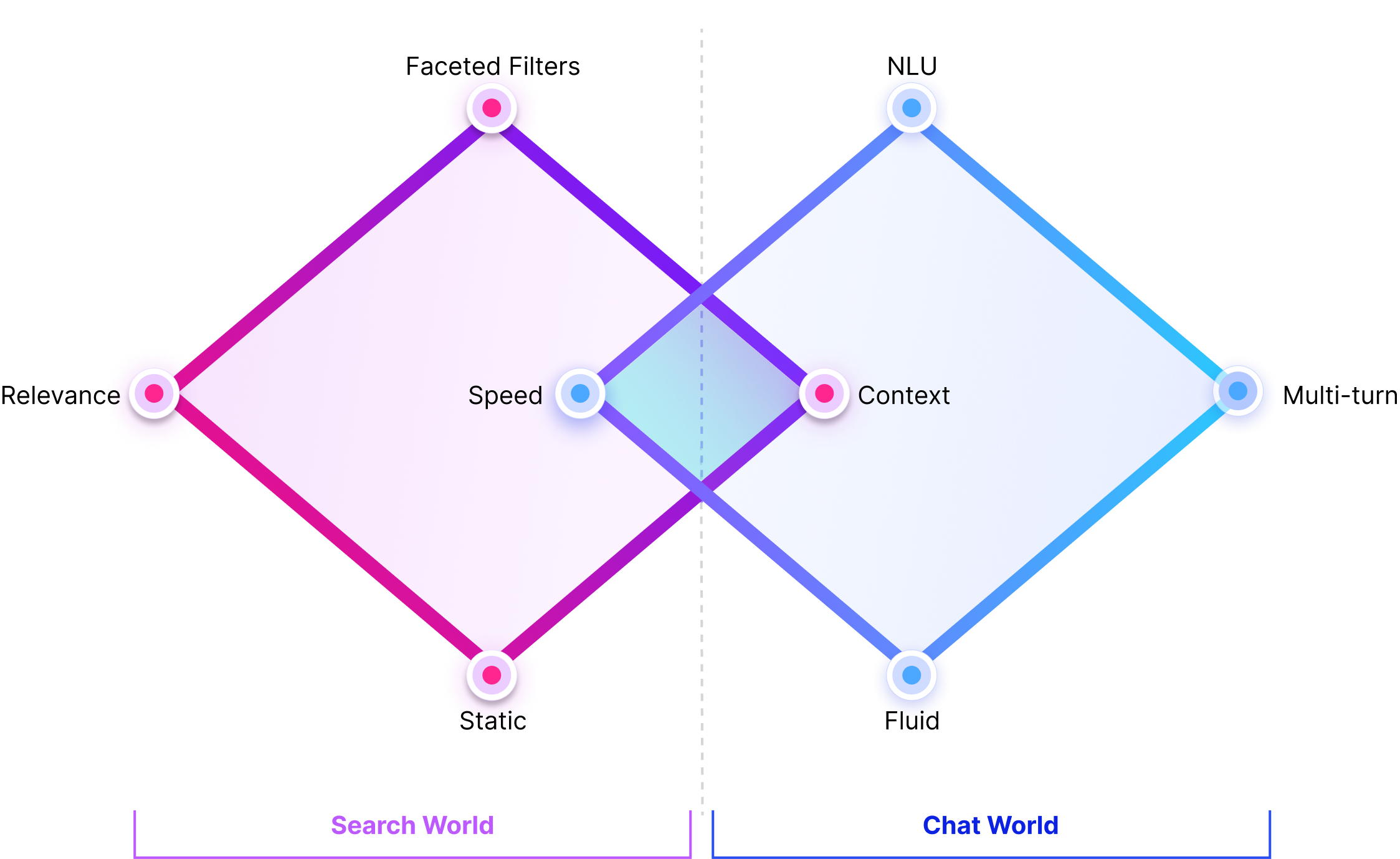
Power of Search. Ease of Chat.
The convergence of search and chat technologies is poised to redefine the digital landscape, merging the precision of search engines with the conversational fluidity of chat- based systems. This integration heralds a transformative shift in user experience, enabling seamless, context-aware interactions. By combining the immediacy of search with the personalized engagement of chat, users can now access information, make decisions, and complete tasks in a more intuitive and efficient manner. Flyfish.ai is pioneering this fusion, exploring its transformative potential to revolutionize digital experiences across industries, from education to e-commerce.
The fusion of Search and Chat demands a hybrid model that blends the structured, data- rich capabilities of traditional search engines with the intuitive, context-aware engagement of chat interfaces. This new paradigm enhances accessibility by breaking down the linearity of search, offering users the ability to refine queries in real-time, seek clarifications, and explore topics in depth—all through natural conversation. By transforming static searches into interactive exchanges, the Searchat experience paves the way for seamless decision- making, informed discovery, and a more nuanced, human-centric digital interaction.Early attempts to unify Search and Chat have fallen short, often delivering fragmented, inconsistent experiences that fail to meet user expectations. To unlock its full potential, the Search + Chat experience must be reimagined with seamless integration, advanced contextual intelligence.
The Search Dilemma:
Relevance in an Era of Overchoice
A robust search experience hinges on precision, speed, and relevance. It relies on algorithms that help in quick query interpretation, intuitive autocomplete suggestions, and superfast result delivery. Features like faceted filters enrich user engagement by tailoring results to individual preferences. At its core, search accelerates decision-making, boosts task efficiency, and empowers users to explore, learn, and act with confidence and ease. However, the rapidly evolving intersection of consumer expectations and available search technology presents both challenges and opportunities.
For decades, search has reigned as the cornerstone of digital discovery. Yet, its effectiveness is increasingly being questioned in the face of overwhelming choices and information overload, which often leads to decision fatigue. While filters help narrow options, they are no longer sufficient for delivering precise, meaningful recommendations. A new approach is needed—one that transcends traditional filters and reimagines search functionality. Besides, emerging modalities like visual and voice searches demand a fundamental redesign of traditional search interfaces to adapt to changing user behaviors. And the influence of sponsored and marketer-driven search results continues to undermine trust and relevance. These issues raise critical questions:
- How can we harness the power of speed while mitigating information overload?
- How do we achieve true personalization without overt marketer-driven agendas?
- And how do we facilitate effortless discovery without relying on outdated filters
The path forward lies in rethinking search as more than a tool for finding information. It must evolve into a dynamic, intuitive system that empowers users, and adapts seamlessly to emerging consumer behavior.
The Chat Challenge:
Robotic Replies to Emotional Engagement
A superior chat experience is defined by its conversational fluidity, deep contextual understanding, and the ability to deliver personalized responses. It’s core features include advanced natural language understanding for intuitive communication, adaptive learning to refine interactions, and support for multi-turn conversations to sustain engagement.Integration with multimedia elements and multilingual capabilities enhance interactivity and accessibility. A well-designed chat interface simplifies complex tasks, nurtures user trust, and creates a seamless, empathetic digital journey tailored to individual needs.
While chat has become the de facto interface in applications like customer support, social messaging, and enterprise collaboration tools, significant challenges remain unresolved. These include the inability to fully comprehend slang or diverse linguistic expressions, difficulty maintaining performance and accuracy under high user loads or dynamic environments, and challenges in generating responses that are precise, and contextually relevant. These limitations raise a different set of questions:
- How can we incorporate emotional intelligence in chat conversations?
- How can we handle ambiguity in chat without conversational dead ends?
- How do we maintain context across multi-turn conversations?
The next evolution of chat systems must address these challenges by advancing capabilities to handle intricate, multi-step, or domain-specific queries with precision. Achieving robust contextual understanding, maintaining scalability, and ensuring a natural conversational flow are essential to meeting user expectations. Overcoming these hurdles will redefine chat interfaces into powerful tools for intelligent digital interactions.
Unlocking the Potential of Search + Chat:
Key Challenges
Unifying the best of search and chat creates a transformative, intuitive, and highly effective user experience. However, achieving this integration is challenging due to the fundamentally different architectures and user expectations of these systems. Search is optimized for precision and speed, delivering static outputs, while chat focuses on conversational flow and contextual understanding. Merging these requires combining structured data retrieval with adaptive, multi-turn dialogue systems. The challenges include managing relevance, avoiding conflicting responses, and addressing scalability and latency. The unified Searchat engine must blend the structured precision of search with the conversational fluidity of chat to provide users with dynamic, interactive access to information.

The best of both the worlds
The fusion begins with intelligent query handling, allowing users to perform traditional searches or ask complex, multi-layered questions in a conversational manner. Adaptive algorithms refine results in real-time by interpreting user intent. Contextual understanding ensures accuracy, while features like multimodal and multilingual support enhance accessibility. Effortless transitions between static results and conversational explanations create an intuitive, engaging experience. By reducing information overload and improving decision-making, this seamless integration delivers a dynamic, personalized interface that anticipates user needs and adapts intelligently to provide optimal outcomes. This necessitates a new framework.
Response Adaptive Recommendation Engine (RARE)
The Response Adaptive Recommendation Engine (RARE) is a cutting-edge framework designed to combine structured precision of search with conversational flexibility. RARE is built on ten core elements:
- Meta Intent Identification: MII interprets the underlying meta-intent behind user queries, considering context and goal rather than just the comprehension of direct intent.
- Intelligent SplitFire: ISF Breaks down user’s direct intent into dynamically categorized multiple intents auto-triggered based on a specific domain.
- Hybrid Search + Chat Algorithms: Combined search and chat functions process semantic meaning of vector representations of words and finetuned for response generation from specific datasets.
- Contextual Representation: Real-time context tracking to interpret intent dynamically, adapting to evolving user inputs in multi-turn conversations.
- Dynamic Query Transformation: Modifies queries on-the-fly based on context at every turn, refining search results as the conversation progresses.
- Adaptive Personalization: Employs AI-driven profiling and behavioral insights to deliver responses tailored to individual preferences, including customized suggestions, filters, and follow-up actions.
- Relevant Response Configuration: Continuously recalculates results in real time, using updated attributes and presenting refined options for further exploration.
- Composition and Orchestration: Seamlessly integrates search results, conversational flows, and interaction modes while dynamically adjusting layouts, content formats, and user experience based on contextual relevance.
- Unified Experience: Provides a multimodal Searchat interface that combines personalization, insights, and call-to-actions into a cohesive user journey.
- Proactive Evolution: Learns and evolves over time to refine the experience, offering predictive suggestions and proactive follow-ups based on prior interactions to boost decision-making and engagement.

Response Adaptive Recommendation Engine (RARE)
At its core, the RARE framework adheres to User-Resonant Design (URD) principles, ensuring adaptive and cohesive responses throughout the interaction. By blending precision, adaptability, and personalization, RARE sets a new standard for conversational recommendation systems, ideal for modern digital experiences.
Here are a few examples of Searchat implementations.

Search like results in a conversational interface

Context Continuation in a search like interface

Dynamic Interface Switchover in the same interface for a fashion stylist

Dynamic Interface Switchover for a text based response in the same interaction

Another interface showing conversation + chat interacting with each other
Top Challenges in Building Searchat Experiences
Implementing the RARE framework for Searchat experiences involves addressing several critical challenges. These include dynamically segmenting user intent, managing real-time context through personalized query transformations, and orchestrating seamless interactions. The three most critical challenges, outlined below, are pivotal to delivering a cohesive, efficient, and engaging user experience.
Dynamic Intent Segmentation and Algorithm Application: Splitting user intent into dynamically triggered attributes specific to a domain and seamlessly applying a diverse set of search and chat algorithms requires advanced algorithms and precise domain understanding.
Context Management and Personalized Query Transformation: Effectively managing real-time context while dynamically transforming user queries and incorporating personalization insights presents a significant challenge, requiring robust AI models with seamless integration of user data.
Orchestrating a Unified and Latency-Free Experience: Coordinating hybrid algorithms, real-time contextual updates, and dynamic interface adaptability into a cohesive, efficient user journey demands a sophisticated system architecture and meticulous fine-tuning across domains.
Our RARE framework addresses these key challenges with advanced AI models, domain- specific models, and robust system design. Continuous fine-tuning, data-driven insights, and proactive system orchestration are vital to overcoming these hurdles and delivering exceptional eperiences.




















































